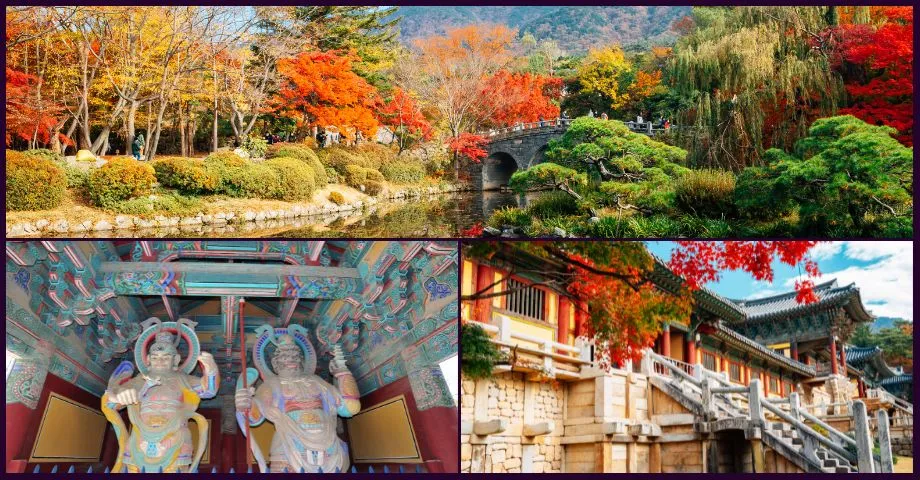Autumn 2023 marked my journey to Gyeongju, South Korea, a city steeped in history and adorned with the vibrant hues of fall foliage. This blog post is about my trip to Bulguksa Temple in Gyeongju, South Korea, an ancient Buddhist sanctuary and a UNESCO heritage site nestled on the slopes of Tohamsan.
Let me take you through the captivating experience of exploring this cultural and historical gem.
A Trip to Bulguksa Temple in Gyeongju, South Korea
Temple of the Buddha Land and Cloud Bridges:
Bulguksa, meaning “Temple of the Buddha Land,” is a testament to Korea’s rich cultural heritage. As I entered through Sokgyemun, the temple’s entrance, a double-sectioned staircase, welcomed me—a symbolic ascent of 33 steps mirroring the path to enlightenment. The Cheongungyo (Blue Cloud Bridge) and Baegungyo (White Cloud Bridge) led the way, adorned with intricate carvings and designated National Treasure No. 23.
Stone Pagodas Standing Tall:
The temple grounds house two remarkable stone pagodas, each with unique charm. Seokgatap, a three-story structure, dates back over 13 centuries, reflecting traditional Korean-style simplicity. Dabotap, on the other hand, standing at 10.4 meters, is dedicated to the Many Treasures Buddha, featuring a highly ornate structure and gracing the South Korean 10 won coin. Together, they are Korean National Treasures No. 20 and 21, respectively.
Journey through Enlightenment:
Ascending the stairway led me to Jahamun, the Mauve Mist Gate, a transition point to the temple’s heart. Daeungjeon, the Hall of Great Enlightenment, stood majestically, enshrining the Sakyamuni Buddha. Adjacent was Museoljeon, the Hall of No Words, a structure echoing the belief that Buddha’s teachings transcend mere words. The Gwaneumjeon, housing the Avalokitesvara, offered a serene retreat at the complex’s highest point.
Cultural Flow and Preservation:
Bulguksa embodies the harmonious coexistence of the terrestrial and celestial realms. The terrestrial, with the Shakyamuni Buddha Lotus Sutra, and the celestial, with Amitabha Buddha Avatamska Sutra, converge within this vast temple complex. As I explored the two courts centered around Daeungjeon and Geungnakjeon, I marveled at the preservation of these structures from the original Silla construction.
History Carved in Stone:
Bulguksa’s records trace its origins to 528, under King Beopheung. However, as we see it today, the present temple was constructed in 751 under King Gyeongdeok, initiated by chief minister Kim Daeseong. Through the Goryeo and early Joseon Dynasties, Bulguksa underwent renovations. Tragically, during the Imjin Wars, wooden buildings were reduced to ashes. Yet, the resilience of Bulguksa prevailed, with reconstruction efforts beginning in 1604 and continuing through about 40 renovations until 1805.
Post-War Renaissance and Restoration:
The aftermath of World War II and the Korean War cast a shadow over Bulguksa, leading to a partial restoration in 1966. However, it was under the initiative of President Park Chung Hee between 1969 and 1973 that extensive archaeological investigations and significant restoration efforts revived Bulguksa to its current form. The stone structures that greet visitors today are a testament to the meticulous preservation of Silla-era artistry.
Personal Reflections on Autumn 2023:
My autumn visit to Bulguksa unfolded against fiery red and golden leaves. The crisp air carried a sense of tranquility as I wandered through the temple’s courtyards, each step revealing intricate details and centuries-old stories. The stone pagodas, adorned with fallen leaves, stood as silent witnesses to the changing seasons and the enduring spirit of Bulguksa.
Preserving Delicate Carvings and Fading Lotus Flowers:
As I traversed the Lotus Flower Bridge, designated National Treasure No. 22, I marveled at the delicate carvings that have weathered the weight of countless pilgrims. And, with its faded Lotus Flowers on each step, this bridge served as a poignant reminder of the passage of time and the enduring beauty of Bulguksa’s craftsmanship.
Bulguksa National Treasures:
Bulguksa’s status as a repository of national treasures is evident in the Yeonhwagyo (Lotus Flower Bridge) and Chilbogyo (Seven Treasures Bridge), designated as National Treasure No. 22. These bridges, along with the Cheongungyo (Blue Cloud Bridge) and Baegungyo (White Cloud Bridge), are a testament to Silla-style bridge architecture and were designated as National Treasure No. 23.
My Trip to Bulguksa Temple in Gyeongju:
As I conclude my visit to Bulguksa, the echoes of ancient chants and the rustle of autumn leaves linger in my memory. This cultural pilgrimage through South Korea‘s historic temple revealed the intricate details of Buddhist artistry and left an indelible mark on my appreciation for the country’s rich cultural heritage. Bulguksa, with its timeless grandeur, stands as a living testament to the enduring spirit of Korean Buddhism and craftsmanship.
